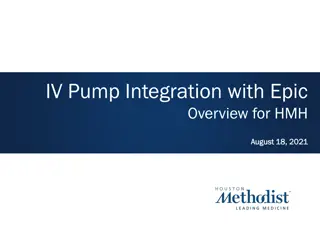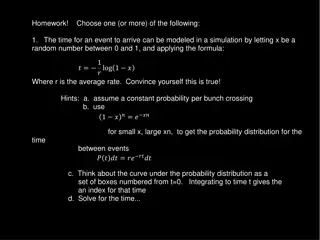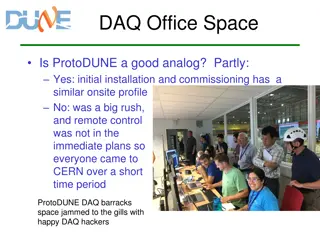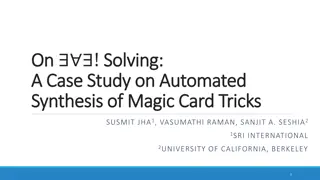Integration of End-of-Stave Card with ePIC DAQ: FLX Expectations
In the realm of detector electronics, the integration of the End-of-Stave Card with ePIC DAQ is explored extensively through the FLX expectations set by the Electronics and DAQ Working Group. This integration involves various components such as the Global Timing Unit (GTU), Collider interfaces, Run Control, DAM configurations, Clock and Timing mechanisms, different sensor technologies, bias distribution, data aggregation, software triggers, and more. The collaborative efforts of Fernando Barbosa, Jeff Landgraf, and Jin Huang steer the exploration towards a common design and functionality across multiple channels and sensor types for the future enhancement of experimental setups.
Download Presentation

Please find below an Image/Link to download the presentation.
The content on the website is provided AS IS for your information and personal use only. It may not be sold, licensed, or shared on other websites without obtaining consent from the author.If you encounter any issues during the download, it is possible that the publisher has removed the file from their server.
You are allowed to download the files provided on this website for personal or commercial use, subject to the condition that they are used lawfully. All files are the property of their respective owners.
The content on the website is provided AS IS for your information and personal use only. It may not be sold, licensed, or shared on other websites without obtaining consent from the author.
E N D
Presentation Transcript
Integration of End-of-Stave Card with ePIC DAQ: FLX expectations (ePIC RDO) Electronics and DAQ WG Conveners: Fernando Barbosa, Jeff Landgraf, Jin Huang 1
ePIC Readout Chain Global Timing Unit (GTU) -Interfaces to Collider, Run Control & DAM -Config & Control -Clock & Timing On Detector SMT BGA Sensor Adapter Front End Board (FEB) Readout Board (RDO) Computing Name Data Aggregation Module (DAM) Detector Specific Detector Specific Detector Specific Few Variants Common Design Common Multi-Channel Sensor -HV/Bias Distribution -HV divider -Interconnect Routing -Amplification -Shaping -Digitization -Zero Suppression -Bias Control & Monitoring -Communication -Aggregation -Formatting -Data Readout -Config & Control -Clock & Timing -Data Buffering and Sinking -Calibration Support -QA/Scalers -Collider Feedback -Event ID/Building -Software Trigger -Monitoring Function -Computing Interface -Aggregation -Software Trigger -Config & Control -Clock & Timing MAPS, AC-LGAD MPGD, MCP-PMT SiPM, LAPPD -Sensor Specific -Passive -ASIC/ADC -Discrete -Serial Link -FPGA -Fiber Link Attributes -Large FPGA -PCIe -Ethernet -COTS -Ethernet 1/11/2024 Barrel ECal Workfest 2
ePIC Readout Chain Global Timing Unit (GTU) -Interfaces to Collider, Run Control & DAM -Config & Control -Clock & Timing On Detector SMT BGA Sensor Adapter Front End Board (FEB) Readout Board (RDO) Computing Name Data Aggregation Module (DAM) Detector Specific Detector Specific Detector Specific Few Variants Common Design Common Function Astropix Sensors and Stave s Multi-Channel Sensor -HV/Bias Distribution -HV divider -Interconnect Routing -Amplification -Shaping -Digitization -Zero Suppression -Bias Control & Monitoring -Communication -Aggregation -Formatting -Data Readout -Config & Control -Clock & Timing -Data Buffering and Sinking -Calibration Support -QA/Scalers -Collider Feedback -Event ID/Building -Software Trigger -Monitoring -Computing Interface -Aggregation -Software Trigger -Config & Control -Clock & Timing End-of-Stave Card MAPS, AC-LGAD MPGD, MCP-PMT SiPM, LAPPD -Sensor Specific -Passive -ASIC/ADC -Discrete -Serial Link -FPGA -Fiber Link Attributes -Large FPGA -PCIe -Ethernet -COTS -Ethernet 1/11/2024 Barrel ECal Workfest 3
Streaming in ePIC ePIC DAQ Definition of streaming is No L0 trigger No system wide deadtime in normal operation Detectors will have minimum double hit times for channels or modules, as well as throughput limitations. Collaboration should have the full ability to make data selection cuts on the widest possible criteria Full flexibility for event selection As full flexibility for data selection as possible As full background characterization as possible But subject to an overall throughput budget of ~100Gb/sec ePIC Streaming will include Capabilities for software triggering Capabilities for hardware triggering Capability for flow control Zero suppression & aggregation within data packets ePIC Computing Definition of streaming is Process data as it arrives Physics event selection and tagging Fast Analysis (~3 weeks not months or years) using automation of calibration and reconstruction. Fast understanding of operations needs Fast understanding of calibration Fast publication Distributed analysis Efficient use of diverse architectures (eg. Support for GPU) Efficient use of diverse software (eg. AI) Incorporate worldwide computing facility contributions Overlap between DAQ and computing Automation of Calibrations QA and monitoring Consistent schemes and language for managing data and metadata Event Selection and Tagging 1/11/2024 Barrel ECal Workfest 4
Streaming in ePIC ePIC DAQ Definition of streaming is No L0 trigger No system wide deadtime in normal operation Detectors will have minimum double hit times for channels or modules, as well as throughput limitations. Collaboration should have the full ability to make data selection cuts on the widest possible criteria Full flexibility for event selection As full flexibility for data selection as possible As full background characterization as possible But subject to an overall throughput budget of ~100Gb/sec ePIC Streaming will include Capabilities for software triggering Capabilities for hardware triggering Capability for flow control Zero suppression & aggregation within data packets ePIC Computing Definition of streaming is Process data as it arrives Physics event selection and tagging Fast Analysis (~3 weeks not months or years) using automation of calibration and reconstruction. Fast understanding of operations needs Fast understanding of calibration Fast publication Distributed analysis Efficient use of diverse architectures (eg. Support for GPU) Efficient use of diverse software (eg. AI) Incorporate worldwide computing facility contributions Accept trigger commands needed by Sensors/ASICS (charge injection, LED etc ) Provide Clocks Aggregate and package serial data from FEB Expectations for RDO (with respect to detector readout): Use clock synchronized to (multiple of) EIC bunch crossing clock Identify times with global Bunch Number Provide information to define times with respect to global Bunch Number in data Mark begin/end of time frames (under GTU direction) Pass user/commands (including potential trigger information) to next stage Support FEB sensor/ASIC requirements Overlap between DAQ and computing Automation of Calibrations QA and monitoring Consistent schemes and language for managing data and metadata Event Selection and Tagging RDO not expected to: Buffer data for triggering 1/11/2024 Barrel ECal Workfest 5
Optical Protocol Requirements The High-Level Optical Protocol RDO FEB Defines the information content of the data flow between the GTU, RDO, and DAM boards FEB RDO Optical Protocol Requirements Timing <=5ps Resolution for hi-res Detectors <=100ps for All detectors Phase stability on power cycle Configuration of RDO firmware and ASIC parameters Mode for configuring RDO Mode for ASIC configuration passthrough Real-Time Command / Control Define bunch crossing counter Define time frames Trigger Information Mark or initiate calibration events Potential debug or fallback triggered modes Formatting information Flow Control RDOs need to mark potential dropped data Need the capability of applying global busy Slow Control Monitoring from ASICs/FEBs (e.g. Temperature monitoring) Data Transfer (>=10Gb/s per RDO) RDO RDO FEB FEB RDO RDO FEB FEB GTU GTU 6 1/11/2024 Barrel ECal Workfest
System Component Status: RDO and GTU The hardware development of the RDO and GTU is currently focused on the development of the low-level timing protocol for achieving the 5ps time resolution requirement. We prefer using a reconstructed clock to avoid extra fiber Study the underlying timing protocol for GTU->DAM link and DAM->RDO link using dev-kits & FELIX 182 Specify the information protocol Details of time frame Details of flow control Implementation of software triggering Data volume studies need to be extended to the channel level in to study detailed rates needed by components Mocked up physical characteristics Assume Artix Ultrascale+, 2.5 x 2.5 inches for common components + connector space 2-5 Watts power 7 1/11/2024 Barrel ECal Workfest
(William Gu, Dec 21, 2023 DAQ WG) RDO, pre-prototype Working on the schematics Fully assembled boards are expected in the summer of 2024 1/11/2024 Barrel ECal Workfest 8
System Component Status: DAM DAM Candidate We have FELIX FLX-182 in hand and are evaluating Expect to use upcoming FLX-155 Additional LTI interfaces 48 ports Discussing need/desire for additional modifications Direct link to Si5345 Direct links to versal XPIO pins Current Expectation for Imaging Calorimeter is: ~230 RDO 5 DAM 9 1/11/2024 Barrel ECal Workfest
Questions:? 1/11/2024 Barrel ECal Workfest 10























